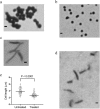GC-MS analysis of Myrtus communis extract and its antibacterial activity against Gram-positive bacteria
- PMID: 32183818
- PMCID: PMC7077171
- DOI: 10.1186/s12906-020-2863-3
GC-MS analysis of Myrtus communis extract and its antibacterial activity against Gram-positive bacteria
Abstract
Background: Myrtus communis is a typical plant of Mediterranean area. The different parts of this plant such as berries, branches, and leaves have been used worldwide as a traditional/folk medicine for the treatment of various ailments and diseases.
Methods: Ethanolic leaf extract of the plant was prepared by Soxhlet extraction method. Zone of inhibition, minimum inhibitory concentration and minimal bactericidal concentration were determined by well diffusion method and microplate alamar blue assay. GC-MS analysis was carried out to identify the compounds present in the extract. Microscopy and ImageJ software were used respectively for morphology and cell-length measurements. GraphPad Prism was used for statistical analysis.
Results: The ethanolic extract showed strong inhibitory effect against Gram-positive and acid-fast bacteria with significant inhibition-zone size (9-25 mm), MIC (4.87-78 μg/ml), as well as MBC (0.3-20 mg/ml). However, no effect was observed on the growth of Gram-negative bacteria. The growth inhibition was found to be associated with the damage of cell wall as the extract-treated cells were sensitive to cell wall-targeting antibiotics and displayed the cell wall damage-depicting morphological defects. GC-MS analysis confirmed the presence of novel compounds in addition to the most representative compounds of the essential oils/extracts of M. communis of other country origins.
Conclusion: These results demonstrate that M. communis leaf extract could be the source of compounds to be used for the treatment of Gram-positive bacterial infections. This is the first report, which provides insights into the mechanism of action of the extract in inhibiting the growth of Gram-positive bacteria.
Keywords: Cell wall; GC-MS; Gram-negative bacteria; Gram-positive bacteria; Myrtus communis; Plant extract.
Conflict of interest statement
The authors declare that there is no conflict of interest of this study.
Figures


Similar articles
-
Myrtus communis essential oil: chemical composition and antimicrobial activities against food spoilage pathogens.Chem Biodivers. 2014 Apr;11(4):571-80. doi: 10.1002/cbdv.201300153. Chem Biodivers. 2014. PMID: 24706627
-
Antibacterial activities of the methanol extract, fractions and compounds from Elaeophorbia drupifera (Thonn.) Stapf. (Euphorbiaceae).BMC Complement Altern Med. 2017 Jan 7;17(1):28. doi: 10.1186/s12906-016-1509-y. BMC Complement Altern Med. 2017. PMID: 28061888 Free PMC article.
-
A new antibacterial dibenzofuran-type phloroglucinol from myrtus communis linn.Nat Prod Res. 2020 Nov;34(22):3199-3204. doi: 10.1080/14786419.2018.1556657. Epub 2019 Jan 28. Nat Prod Res. 2020. PMID: 30689408
-
Review of pharmacological effects of Myrtus communis L. and its active constituents.Phytother Res. 2014 Aug;28(8):1125-36. doi: 10.1002/ptr.5122. Epub 2014 Feb 4. Phytother Res. 2014. PMID: 24497171 Review.
-
The therapeutic value of Myrtus communis L.: an updated review.Naunyn Schmiedebergs Arch Pharmacol. 2024 Jul;397(7):4579-4600. doi: 10.1007/s00210-024-02958-3. Epub 2024 Feb 6. Naunyn Schmiedebergs Arch Pharmacol. 2024. PMID: 38319389 Free PMC article. Review.
Cited by
-
Myrtus communis leaf compounds as novel inhibitors of quorum sensing-regulated virulence factors and biofilm formation: In vitro and in silico investigations.Biofilm. 2024 Jun 10;8:100205. doi: 10.1016/j.bioflm.2024.100205. eCollection 2024 Dec. Biofilm. 2024. PMID: 38988475 Free PMC article.
-
Antibacterial and Antibiofilm Activities of β-Lapachone by Modulating the Catalase Enzyme.Antibiotics (Basel). 2023 Mar 14;12(3):576. doi: 10.3390/antibiotics12030576. Antibiotics (Basel). 2023. PMID: 36978443 Free PMC article.
-
Deciphering the anti-neoplastic potential of Allium ascalonicum in averting the proliferation and epithelial-mesenchymal transition of triple-negative breast cancer through virtual docking and In Vitro approaches.BMC Cancer. 2025 Mar 7;25(1):414. doi: 10.1186/s12885-025-13796-8. BMC Cancer. 2025. PMID: 40055656 Free PMC article.
-
Myrtle: a versatile medicinal plant.Nutrire. 2023;48(1):10. doi: 10.1186/s41110-023-00194-y. Epub 2023 Feb 16. Nutrire. 2023. PMID: 38625264 Free PMC article. Review.
-
From Environmental Toxicants to Antibacterial Agents: BPA Analogues Selectively Inhibit the Growth of Gram-Positive Bacteria by Disturbing Biosynthesis of the Cell Wall.Environ Health (Wash). 2023 Sep 7;1(4):291-299. doi: 10.1021/envhealth.3c00092. eCollection 2023 Oct 20. Environ Health (Wash). 2023. PMID: 39474497 Free PMC article.
References
-
- Rocha LG, Almeida JR, Macedo RO, Barbosa-Filho JM. A review of natural products with antileishmanial activity. Phytomedicine. 2005;12(6–7):514–535. - PubMed
-
- Aleksic V, Knezevic P. Antimicrobial and antioxidative activity of extracts and essential oils of Myrtus communis L. Microbiol Res. 2014;169(4):240–254. - PubMed
-
- Alipour G, Dashti S, Hosseinzadeh H. Review of pharmacological effects of Myrtus communis L. and its active constituents. Phytother Res. 2014;28(8):1125–1136. - PubMed
-
- Bravo L. Polyphenols: chemistry, dietary sources, metabolism, and nutritional significance. Nutr Rev. 1998;56(11):317–333. - PubMed
MeSH terms
Substances
Grants and funding
LinkOut - more resources
Full Text Sources
Medical
Miscellaneous

